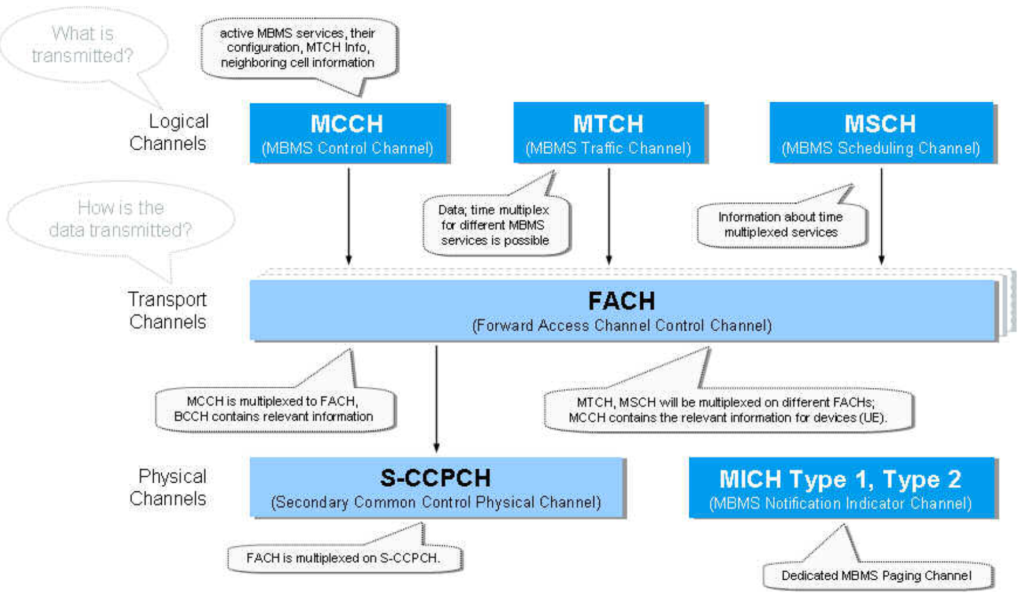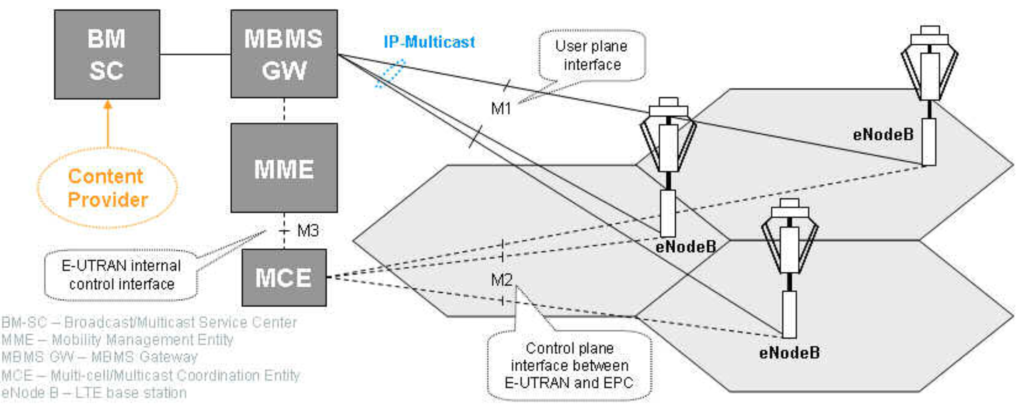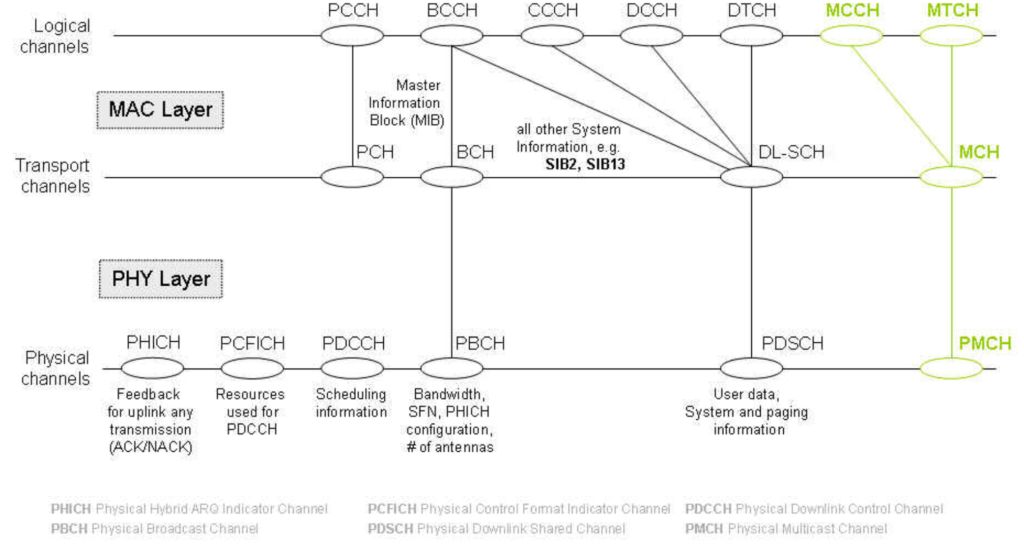Multicast-Broadcast Single Frequency Network (MBSFN) is a feature of LTE, designed to efficiently deliver multimedia services such as mobile TV, video streaming, and emergency alerts. MBSFN enables simultaneous transmission of identical content over a single frequency network, optimizing spectrum usage and enhancing network performance.
How MBSFN Works
In MBSFN, multiple base stations transmit the same data synchronously, creating a single frequency network. This synchronized transmission forms a large virtual cell, allowing multiple users to receive the broadcast simultaneously with improved signal quality, especially in cell edge areas.
Introduction to MBMS in 3GPP Networks
Multimedia Broadcast Multicast Service (MBMS) was first specified in 3GPP Release 6, initially for UTRAN/WCDMA (3G) and later extended to GERAN/GSM (2G). MBMS allows network operators to broadcast over their cellular networks, offering advantages such as using existing infrastructure, no need for additional spectrum, and the possibility of user interaction via the uplink.

Key Features of MBMS:
- Minimal Network Impact:
- Only one new network element introduced.
- Existing nodes received new tasks.
- Terminal Enhancements:
- Three new logical channels for MBMS services.
- One new physical channel to inform terminals about MBMS service availability.
MBMS Advantages Over Traditional Broadcast Technologies:
- Utilizes existing cellular infrastructure.
- Eliminates the need for additional spectrum.
- Enables user interaction through the uplink.
MBMS Network Architecture:
- Minimal changes to existing network architecture.
- Enhanced channel model to support broadcast and multicast services.
The architecture allows MBMS to integrate seamlessly with existing 2G and 3G networks, providing a robust platform for multimedia broadcasting.

MBMS in LTE.
eMBMS in LTE (3GPP Release 8 and 9) Explained
Multimedia Broadcast Multicast Service (MBMS) initially provided 6 mobile TV channels at 128 kbps in a 5 MHz channel for UMTS/WCDMA, but it was not efficient for 2G and 3G. LTE, with its Orthogonal Frequency Division Multiplex (OFDM) technology, improved broadcast capabilities significantly.
Key Features and Enhancements:
- Coverage and Efficiency:
- Good Coverage: Ensures reliable service even at the cell edge.
- Low Power Consumption: Critical for user devices.
- eMBMS (Evolved MBMS):
- Increased Capacity: Offers 20 TV channels at 256 kbps in a 5 MHz channel.
- Single Frequency Network (SFN): Increases spectral efficiency up to 1 bps/Hz.
Network Architecture:
- Simpler and Flatter: LTE has a more streamlined architecture compared to 3G.
- Key Network Elements:
- BM-SC (Broadcast/Multicast Service Center): Manages authentication, content provider authorization, charging, and data flow configuration.
- MBMS Gateway (MBMS GW): Handles the multicast of IP packets and session control.
- Mobile Management Entity (MME): Manages non-access tasks and terminates NAS protocols.
- MCE (Multi-cell/Multicast Coordination Entity): Coordinates resources and transmission parameters across cells in an MBSFN area. It can be integrated directly into the base station or added as a separate network element.

eMBMS was first specified in 3GPP Release 8 (physical layer aspects) and later in Release 9 (higher layer aspects). This phased approach allowed for better planning and implementation of the technology in commercial LTE deployments.
Benefits of eMBMS:
- Uses existing infrastructure: No need for additional spectrum.
- Supports interactivity: Due to the available uplink.
- Enhanced broadcast capabilities: Compared to traditional broadcast technologies.
By addressing the limitations of previous technologies and leveraging LTE’s advanced features, eMBMS offers a robust solution for multimedia broadcasting in modern cellular networks.
MBSFN, MBSFN area
To enable efficient broadcasting in MBMS radio networks, cells transmitting the same content need to be synchronized. This synchronization makes the signal appear to a device as a single transmission, even over a time-dispersive radio channel. This setup is known as a Multimedia Broadcast Single Frequency Network (MBSFN).
An MBSFN area consists of multiple cells that transmit the same content to multiple users. Multiple cells can belong to different MBSFN areas, and each cell can be part of up to eight MBSFN areas. There can be up to 256 different MBSFN areas, each with its own identity. Once defined, MBSFN areas do not change dynamically.
It’s not required for a terminal to receive content from multiple MBSFN areas simultaneously.
For example, in Figure below, we see three different MBSFN areas. Cells 7, 8, and 9 belong to more than one MBSFN area. Some cells in an MBSFN area can be marked as “reserved cells,” meaning they do not support MBMS transmissions. Cell #4 in this figure is an example of a reserved cell.

New channels for MBMS.
To support MBMS in LTE, new logical, transport, and physical channels are required. Figure below provides an overview of the downlink channel concept in LTE with a focus on MBMS aspects.

Logical Channels:
- Multicast Traffic Channel (MTCH):
- Carries data for a specific MBMS service.
- Multiple MTCHs may exist per MBSFN area to accommodate numerous services.
- Uses Radio Link Control (RLC) Unacknowledged Mode (UM) for data transmission because there is no ACK/NACK feedback from terminals due to the broadcast nature.
- Multicast Control Channel (MCCH):
- Provides control information necessary to receive MBMS services.
- Includes subframe allocation and the Modulation Coding Scheme (MCS).
- There is always one MCCH per MBSFN area.
- Also uses RLC UM for data transmission.
Transport and Physical Channels:
- Multicast Channel (MCH):
- Multiplexes one or several MTCHs and one MCCH at the Medium Access Control (MAC) layer.
- The MCH is then multiplexed onto the Physical Multicast Channel (PMCH).
- Physical Multicast Channel (PMCH):
- Transmits the data from multiple LTE base stations within the same MBSFN area.
- No Multiple-Input Multiple-Output (MIMO) transmission is defined for the PMCH.
- Resources such as the number of Resource Blocks (RB) and Modulation Coding Scheme (MCS) are determined by the Multicast Entity (MCE) and signaled to the terminals (UE) via the MCCH.
Additional Notes:
- There is no dynamic adjustment of MCH resources by the eNodeB (e.g., RB, MCS) because the same data is transmitted by several LTE base stations within one MBSFN area.
Features of MBSFN
- Spectrum Efficiency: MBSFN reduces the need for multiple frequency allocations by broadcasting the same content over a single frequency.
- Enhanced Coverage and Signal Quality: Synchronization of multiple base stations minimizes interference and improves signal quality, particularly in challenging reception areas.
- Reduced Network Load: By offloading individual unicast transmissions, MBSFN frees up network resources, enhancing overall efficiency.
- Seamless Integration: MBSFN can be integrated with existing LTE infrastructure, utilizing the same network elements and protocols, making it a cost-effective solution for delivering multimedia content.
Applications of MBSFN
- Mobile TV and Video Streaming: MBSFN is ideal for broadcasting TV channels and live events to large audiences, ensuring consistent quality and wide coverage.
- Emergency Alerts: It is used to disseminate critical information quickly and efficiently during emergencies, reaching a broad audience simultaneously.
- E-Learning and Information Services: MBSFN supports the delivery of educational content and public information services to a large number of users, enhancing accessibility.
Technical Aspects of MBSFN
- Synchronization: Accurate time synchronization among base stations is crucial for MBSFN, typically achieved through GPS or other synchronization mechanisms.
- Resource Allocation: MBSFN requires specific resource blocks within the LTE frame structure, allocated for multicast and broadcast services.
- User Equipment (UE) Capability: UEs must support MBSFN to receive broadcasted content, ensuring compatibility through standard compliance.
Conclusion
MBSFN in LTE is a powerful feature that optimizes the delivery of multimedia services, enhancing spectrum efficiency, coverage, and signal quality. By leveraging synchronized transmissions, MBSFN provides a robust solution for broadcasting content to large audiences, making it an essential component of modern wireless communication networks.